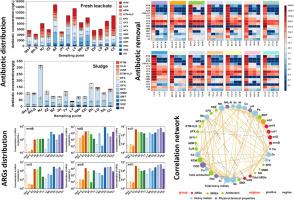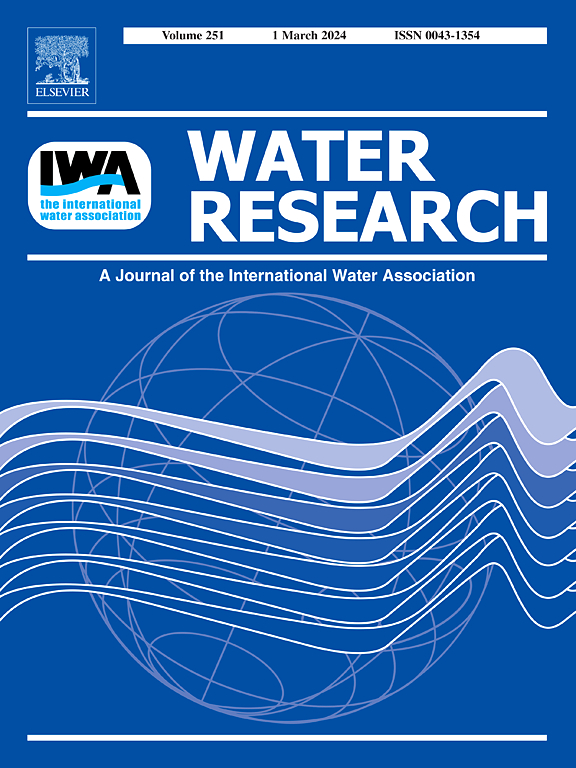Distribution, removal and potential factors affecting antibiotics occurrence in leachate from municipal solid waste incineration plants in China
IF 11.4
1区 环境科学与生态学
Q1 ENGINEERING, ENVIRONMENTAL
引用次数: 0
Abstract
Leachate from municipal solid waste (MSW) incineration harbors a plethora of contaminants, including antibiotics and antibiotic resistance genes (ARGs). However, the understanding of such leachate is markedly scant in comparison to that of landfill leachate. In this study, the distribution and removal of 8 sulfonamides (SAs), 4 quinolones (FQs), and 4 macrolides (MLs) antibiotics in leachate from 14 MSW incineration plants in representative cities across different regions of China were investigated. In addition, potential factors affecting the contamination levels of antibiotics and ARGs in fresh leachate were evaluated. The results showed that the total concentration of target antibiotics in fresh leachate ranged from 4406.1 to 14,930.6 ng/L. Notably, the antibiotic distribution in leachate exhibited regional disparities, influenced by economic status, climatic conditions, and waste separation policies. The absolute abundance of total ARGs ranged from 1.3 × 107–4.0 × 108 copies/mL, with the mobile genetic elements intl1 facilitates the dissemination of qnrS, sul1 and sul2. No distinct regional distribution of the ARGs was observed among different cities. Antibiotic and ARGs distributions were significantly correlated with total organic carbon, pH, ammonia nitrogen, heavy metals, and microbial communities. Moreover, SAs were identified as contributors to the proliferation and spread of corresponding ARGs. Fourteen typical "anaerobic-anoxic/aerobic-anoxic/aerobic-ultrafiltration-nanofiltration " treatment processes removed the target antibiotics effectively (76.1 %-97.0 %). Biodegradation was considered to be the dominant antibiotic removal pathway, removing 62.0 %-90.9 % of antibiotics, while sludge adsorption removed only 1.0 %-11.7 %. This research furnishes valuable insights into the fate of antibiotics in MSW incineration leachate.


求助全文
约1分钟内获得全文
求助全文
来源期刊

Water Research
环境科学-工程:环境
CiteScore
20.80
自引率
9.40%
发文量
1307
审稿时长
38 days
期刊介绍:
Water Research, along with its open access companion journal Water Research X, serves as a platform for publishing original research papers covering various aspects of the science and technology related to the anthropogenic water cycle, water quality, and its management worldwide. The audience targeted by the journal comprises biologists, chemical engineers, chemists, civil engineers, environmental engineers, limnologists, and microbiologists. The scope of the journal include:
•Treatment processes for water and wastewaters (municipal, agricultural, industrial, and on-site treatment), including resource recovery and residuals management;
•Urban hydrology including sewer systems, stormwater management, and green infrastructure;
•Drinking water treatment and distribution;
•Potable and non-potable water reuse;
•Sanitation, public health, and risk assessment;
•Anaerobic digestion, solid and hazardous waste management, including source characterization and the effects and control of leachates and gaseous emissions;
•Contaminants (chemical, microbial, anthropogenic particles such as nanoparticles or microplastics) and related water quality sensing, monitoring, fate, and assessment;
•Anthropogenic impacts on inland, tidal, coastal and urban waters, focusing on surface and ground waters, and point and non-point sources of pollution;
•Environmental restoration, linked to surface water, groundwater and groundwater remediation;
•Analysis of the interfaces between sediments and water, and between water and atmosphere, focusing specifically on anthropogenic impacts;
•Mathematical modelling, systems analysis, machine learning, and beneficial use of big data related to the anthropogenic water cycle;
•Socio-economic, policy, and regulations studies.
 求助内容:
求助内容: 应助结果提醒方式:
应助结果提醒方式:


